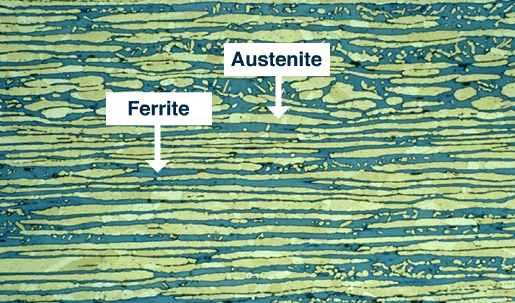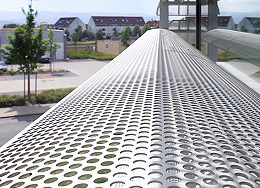
Thống kê
| 1882835 | |
| Số người đang online | 1 |
| Số truy cập hôm nay | 246 |
| Số truy cập tháng này | 57976 |
Quảng cáo
Duplex stainless steel

|
Duplex stainless steel is called "duplex" because they have a two-phase microstructure containing particles of ferritic and austenitic stainless steels. The picture shows the gold austenitic phase as "island" surrounded by green ferritic phase. When duplex stainless steel is melted it has characteristics from liquid to a completely ferritic structure. When the material is cooled to room temperature, about half of transformers with grain austenitic ferritic particles. The result is a microstructure of about 50% and 50% ferrite austenite.
Duplex stainless steel
Duplex stainless steels have a two-phase microstructure of austenite and ferrite beads.
The structure allows them duplex stainless steel is of a combination of attractive attributes:
Strength: Duplex stainless steel has about twice as strong as stainless steel or stainless steel austenitic ferritic often.
Reliability and flexible: Duplex stainless steel has significantly better reliability and ductility than ferritic grades; However, they did not achieve great values of austenitic grades.
Corrosion Resistance: As with all types of stainless steel, corrosion resistance depends mainly on the composition of the stainless steel. For chloride hole and crevice corrosion resistance, our chromium, molybdenum and nitrogen are the most important. Duplex stainless steels have a wide range of corrosion resistance, similar to the range for austenitic stainless steels, ie from 304 or 316 type (eg LDX 2101 ©) to 6% molybdenum (eg SAF 2507 ©) Stainless Steel.
Corrosion pressure: Duplex stainless steel shows corrosion resistance very good pressure (SCC), a property that they have "inherited" from Ferit. SCC can be a problem in certain circumstances (chloride, humidity, high temperatures) for type 304 austenitics such standards and 316.
Cost: Duplex stainless steel with nickel and molybdenum content is lower than their counterparts a similar corrosion resistant austenitic. Due to the low price item alloy, duplex stainless steel lower costs, especially in times of high alloy surcharge. In addition, it can often be reduced thickness portion of duplex stainless steel, due to the strength of its increased productivity compared to austenitic stainless steel. The combination could lead to cost savings and significant weight compared with an austenitic stainless steel solutions.
|
Liên kết website
Hỗ trợ trực tuyến
-
 Liên hệ ngay.Email:ĐT: (08) 6682 3335 - Fax: (08) 6256 2218
Liên hệ ngay.Email:ĐT: (08) 6682 3335 - Fax: (08) 6256 2218
Ngày giờ hiện tại
13/9/2025
clock




